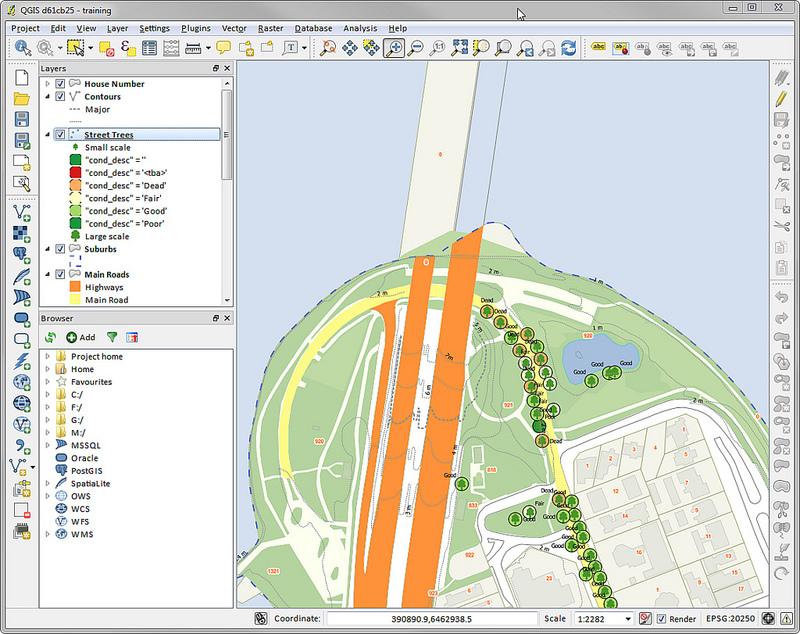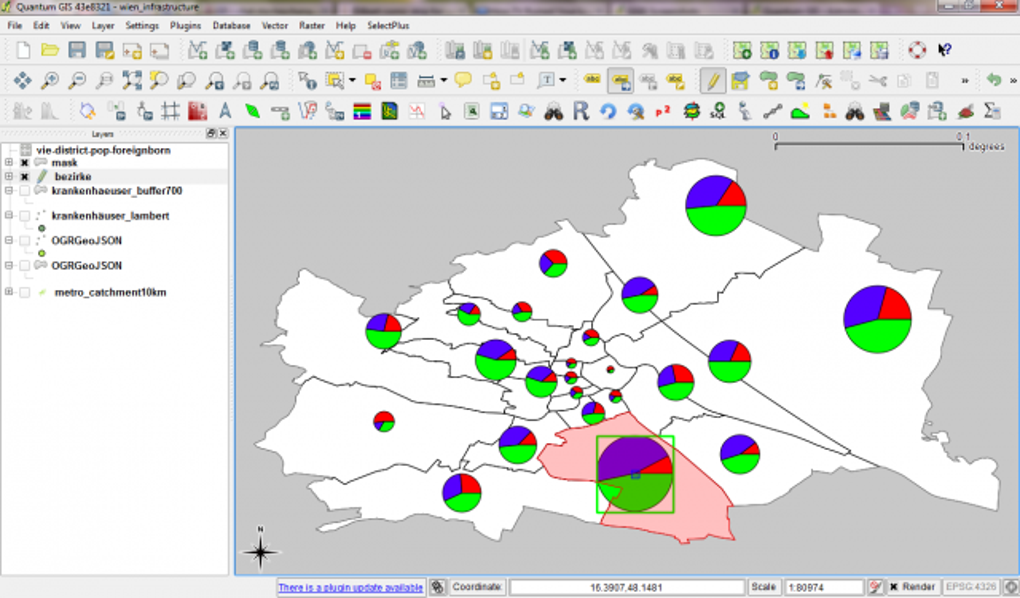QGIS is a user friendly Open Source Geographic Information System (GIS) licensed under the GNU General Public License. QGIS is an official project of the Open Source Geospatial Foundation (OSGeo).
- Quantum GIS is a Geographic Information System, developed to provide different capabilities, like visualizing, managing, editing, analyzing data, and composing printable maps. And apart from its many core functions, it has also been designed to support a growing number of plug-ins.
- Install the latest version of Quantum GIS 2.8.1 - Open-source Geographic Information System (GIS). Download the latest versions of the best Mac apps at safe and trusted MacUpdate Download, install, or update Quantum GIS for Mac from MacUpdate.
Thanks to Quantum GIS (QGIS), you will be able to create and edit maps with ease. The application is quite reliable in its tasks and can be configured to perform lots of different tasks.

Arcgis For Mac

Quantum GIS (QGIS)'s interface is where all the map creation process takes place. From that interface, you can select from a large pool of map templates or start your creation from scratch. You even have the ability to save and use your projects in the future. Various plugins for the integration of GPS capabilities exist as well.
With Quantum GIS (QGIS), the exact positioning of vectors can be selected. It is even possible to include search bar and other useful features one would expect from a virtual map. There is no doubt that Quantum GIS (QGIS) will make your maps look professional.
There are a few software packages and configuration options for those Macintosh users that are interested in running GIS software on their computers. One of the most popular options for running GIS softly directly on within the Macintosh OS environment is QGIS, known formally as Quantum GIS, a free and open source (FOSS) software package. Instructions for installing QGIS on the Mac are here. Other native Macintosh GIS software packages are listed further below in this article.
Running ArcGIS on the Mac
Although Esri has released an app version of ArcGIS for iOS, ArcGIS unfortunately isn’t natively offered as a option for installing on a Macintosh computer. The last native effort by Esri to produce GIS software for the Mac was a ported version of ArcView in the early 1990s that never made it past pre-release. It doesn’t look like Esri will produce a native port of ArcGIS for the Mac in the very near future. From the closing session of the 2011 Esri User Conference:
“We’d love to be on the Mac, but we have engineering priorities…so we have to ask ourselves what’s most important for our users,” said Jack Dangermond. “That focus is very important and we want to make sure that we don’t spread our resources too thin. In theory, we could spread our resources more on platforms and thus less on functionality. But would you want us to slow down advancement of the basic tool in order to deploy on a Mac?”
However, there is a teaser that, at some point ArcGIS will be Mac ready:
“We’ll probably start moving more towards supporting the Mac at the next release after ArcGIS 10.1.”
For those that want to stick with the most popular commercial GIS package, Esri’s ArcGIS software, a separate instance of Windows OS (Windows XP and above) needs to be set up on the Macintosh to run the GIS software. There are two main ways to accomplish this for Intel-based Macs. The first is to set up a dual boot system. Apple offers BootCamp for free as part of its operating system for versions of MacOS that are 10.4 and higher, which, after installation of the software and a licensed Windows OS, gives users the options of either booting up the computer in Macintosh or Windows OS. Booting up as a Windows machine allows the user to run Windows compatible software, which would include ArcGIS. The downside to this option is that the Macintosh installed software and operations are inaccessible while the computer is booted up as a Windows machine; accessing the Macintosh side requires a reboot and vice versa. The plus side is that the user doesn’t need to operate a separate Windows OS computer. Since the computer boots up fully as a Windows machine, memory is not split between the Windows and Macintosh partitions, enabling ArcGIS to run faster as compared to a virtual machine installation.
A second option is to create a virtual machine (VM) on the Macintosh and then install Windows as the operating system that runs on that VM partition. The two leading commercial options are Parallels and VMware Fusion. Both of these virtualization programs require that a licensed copy of Windows OS be installed. The benefit of a VM is that users can toggle back and forth between Mac and Windows programs without having to reboot. Files and directories on the Mac side can be shared with the VM so that programs in Windows can read and write those files. The downside is that memory is split between the two operating systems, meaning ArcGIS and other programs will run more slowly as compared to a native PC or ArcGIS running under BootCamp. Make sure the Macintosh computer you install VM and ArcGIS on has at least 8GB of RAM, preferably 16GB of RAM.
Further resources, software and reviews on the use of GIS and in the Macintosh Operating System.
ArcExplorer
ArcExplorer is the Java based free data viewer from Esri. This program allows you to view and geocode data in shapefile format.
Download Quantum Gis For Ubuntu
ArcVoyager Special Edition
A free package designed expressly for school use, based on ESRI’s ArcView, and available for both Windows and Macintosh systems. ArcVoyager Special Edition contains runtime ArcView and come with pre-packaged data.
Cartographica
Commercial software package for Mac OS featuring: Support for a huge number of import formats, including popular Raster formats, manual editing and georeferencing, automatic geocoding, integration with online mapping, output to large-format printers. Thirty-day demo available for downloading.
GeoMax
A list of various GIS resources available for Macintosh. Remote sensing software, GIS, and GPS solutions available on the Macintosh platform are listed there.
Gis Software Mac
GRASS
This is probably the most well-known open source and original GIS software applications. GRASS is a raster-based GIS, vector GIS, image processing system, graphics production system, data management system, and spatial modeling system. GRASS can be downloaded for free.
Gis Software Download
gvSIG
gvSIG is an open source GIS application written in Java.
MacDEM
MacDEM is an application to view and edit digitial elevation model (DEM) files for the Mac OS.
MyWorld GIS
A cross-platform GIS focused on educational users.
OpenJUMP GIS
OpenJUMP GIS is an open source GIS written in Java through a collaborative effort by volunteers. Formerly known as JUMP GIS, the application can read shapefiles and GML format files.
Ortellius
Ortelius, a “map illustration software” per the Map Diva web site has launched. The debut of this software package adds one more selection to the very limited mapping software options out there for Macintosh users. A free trial download is available and the Map Diva site is offering a lower introductory price until September 30th. Visit Map Diva to learn more about the software.
Free Quantum Gis Download
Installing QGIS on the Mac
Also referred to as QGIS, Quantum GIS is an Open Source Geographic Information System (GIS) that runs on Linux, Unix, Mac OSX, and Windows. Learning specifically about what frameworks are required before installing and running QGIS on a Mac computer.
TNT Products
Created by Microimages, The TNT Products is a suite of GIS applications for fully integrated GIS, image processing, CAD, TIN, desktop cartography, and geospatial database management. Platforms: Windows, UNIX, Macintosh.
uDig GIS
A Free, Open Source GIS desktop application that runs on Windows, Linux and MacOS. uDig was designed to use OGC’s OpenGIS standards such as WMS, WFS and more. One-click install allows you to view local shapefiles, remote WMS services and even directly edit your own spatial database geometrie